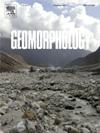Hydraulic and climate controls of hypogene and epigene speleogenesis at a regional scale in northeastern Brazil
IF 3.1
2区 地球科学
Q2 GEOGRAPHY, PHYSICAL
引用次数: 0
Abstract
Hypogene karst and caves have a global distribution but represent only a minor proportion of accessible caves. The recognition of hypogene caves is important across multiple fields as they are commonly associated with metal or hydrocarbon deposits of economic significance. As uplift brings hypogene caves towards the surface, several competing meteoric-related processes promote modification or complete removal of early hypogene diagnostic features. Although the number of case studies related to hypogene speleogenesis is growing, there remains a lack of a regional approach aiming to understand how hypogene karst manifests itself across regional climatic and hydrological transitional profiles and how it interacts with better studied epigene processes in shaping karst dynamics. A 250 km-long north-south transect over Proterozoic Salitre Formation carbonates in northeastern Brazil presented an opportunity to assess the relative importance of hypogene and epigene mechanisms of speleogenesis. By isolating uniform lithological and tectonic parameters along the transect and comparing them with variable climate and hydrological conditions, we have evaluated how these environmental parameters control the manifestation and preservation of distinct types of cave development. We have found that hypogene karst is more prevalent in the drier northern zone, but also occurs in the wetter south, notably in sectors away from major axes of epigene cave development and in areas with a low hydraulic gradient. Overall, hypogene caves tend to be truncated (or erased) by later epigene branchwork passages if located along regional-scale tectonic lineaments or if associated with fracture corridors, and fold or anticlinal structures. As expected, epigene branchwork caves predominate in the wetter southern portion, correlating positively with higher runoff from neighboring quartzite hills. Maze cave sectors are linked to localized floodwater zones, often resulting from sediment plugs and base-level rise. Collapsed zones in caves are associated with cave entrances (resulting in collapse dolines) but also occur in some passages with higher width spans. Proximity to base level inhibits the manifestation of collapse dolines and hypogene and epigene caves, due to sedimentation processes associated with sediment input during seasonal base level floods. Understanding the interplay between hypogene and epigene processes, although challenging, is critical for the correct interpretation of the evolutionary history of caves and karst areas, potentially aiding in the identification of hypogene-related oil and mineral deposits. It can provide valuable insights into how various geomorphological, climatic and hydrological parameters influence the manifestation and preservation of active and relict solutional voids.

求助全文
约1分钟内获得全文
求助全文
来源期刊

Geomorphology
地学-地球科学综合
CiteScore
8.00
自引率
10.30%
发文量
309
审稿时长
3.4 months
期刊介绍:
Our journal''s scope includes geomorphic themes of: tectonics and regional structure; glacial processes and landforms; fluvial sequences, Quaternary environmental change and dating; fluvial processes and landforms; mass movement, slopes and periglacial processes; hillslopes and soil erosion; weathering, karst and soils; aeolian processes and landforms, coastal dunes and arid environments; coastal and marine processes, estuaries and lakes; modelling, theoretical and quantitative geomorphology; DEM, GIS and remote sensing methods and applications; hazards, applied and planetary geomorphology; and volcanics.
 求助内容:
求助内容: 应助结果提醒方式:
应助结果提醒方式:


